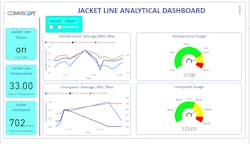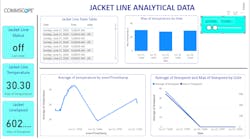IIoT has only scratched the surface in its feasibility within manufacturing environments–many times resulting in lengthy pilots. However, the ability to reduce unscheduled equipment downtime is one area where IIoT has been able to shine.
Hickory, North Carolina-based CommScope has seen the potential firsthand at its manufacturing facility in Goa, India. The machines CommScope uses to jacket its cooper wire products feature a large number of high-speed moving parts. Sometimes, in response to repeated use, these parts can degrade–to the point where these machines stop functioning and need to be repaired. When this happens, not only does the product manufacturing line take a 50% production hit, but the company also has to spend thousands of dollars to fix the machine.
CommScope has developed and deployed a new IIoT application to collect data from these machines and transmit it to the cloud. CommScope can monitor and analyze this data to determine if a machine's parts might be at risk of degrading, or if the machine needs another type of maintenance to prevent it from breaking down when a piece of equipment might need maintenance to prevent it from breaking down, ultimately avoiding unscheduled downtime.
Understanding the Challenges
“The biggest challenge was gathering the resources and finding the time for the IIoT project. All of the people working on the project had other day-to-day responsibilities, and we needed them to carve out time to work on the project,” Sudharshan N., director of IT business systems at CommScope says.
Another challenge was gaining the knowledge needed to install the endpoints in the machines, to set up an on-premises IoT edge server, connect the endpoints to it, and then stream data from the edge server to the cloud platform. “We also had to learn how to connect the cloud platform to a business intelligence application that could output the data to a dashboard,” he says. “Fortunately, our cloud platform partner had a lot of experience with projects like ours and helped us when we experienced problems setting up these IoT technologies and connecting them to each other. Now that we have done it once, we have the knowledge we need to do it much quicker next time.”
Interestingly enough, none of the major challenges related to the technology itself. “With the exception of the endpoints (which we built ourselves) all the technology we needed for the project exists and is mature,” he says. “Once we knew how to use it and put it together, it worked as expected."
The Application
CommScope IoT endpoints collect data from the jacketing machine’s sensors. These endpoints then use TCP/IP and a wired Ethernet connection to transmit this data to CommScope’s on-premises IoT edge server, which is running a Linux virtual machine. The edge server pre-processes and filters this data, then streams it to an IoT cloud platform hosted by the cloud provider.
“Once the data has been ingested in the cloud platform, it is then integrated into a business intelligence application that outputs it on a dashboard. The dashboard allows us to view real-time and historical data on the machine,” he says. “In addition, the IoT cloud platform sends a dashboard and SMS alert to factory personnel if one of the machine’s gearbox temperature passes a threshold that indicates parts in the machine might soon degrade.”
At that point, the factory personnel schedules maintenance during regularly scheduled production line downtime–usually within a day. Most of the time this maintenance can be conducted pretty quickly–the machine just needs some new lubricants, a new ball bearing or a similar minor adjustment or part to prevent it from being damaged or breaking down.
Lessons Learned
One key lesson was to find an IoT project with a narrowly defined use case and clear, tangible benefits, at least for initial IoT projects. “We did this and it made it much easier to quickly develop and deploy the IIoT application, and demonstrate the benefits of IIoT to others at our company,” he says. “In addition, taking on a narrow project has provided our team with the IIoT expertise we need to take on more ambitious and complex IIoT applications in the future.
The project also demonstrated the importance of adopting a data-first mentality. “It is important to remember that the IIoT is at least as much about the use and scalability of the data you are collecting as it is about automating process,” he says. “For example, as you collect and analyze data from your machines, you will be able to unlock insights that can reveal new opportunities to improve various production processes, allowing your company to move from reacting to IIoT data to being proactive with this data. In our case, we are already looking at opportunities to use the data we are collecting from our jacketing machines to help us address problems that sometimes occur when restarting them after an unexpected power failure.”
One other takeaway from the project was that a hybrid approach that combines an on-premises IoT edge server with a cloud IoT platform for the IIoT applications provides a lot of flexibility and can improve performance.
“With a hybrid approach, you can harness the power and agility of the cloud, while not overwhelming your cloud platform with data. Basically, your edge server acts as a traffic cop for your IIoT data, filtering and pre-processing before sending it to the cloud. In addition, though CommScope does not currently need this capability for this particular IIoT application, a hybrid approach enables you to develop applications that require very low latency,” he says. “For example, with a hybrid approach in the future, we could shut down a machine in real-time if the IoT edge server determines the machine might very soon break down or is producing products of sub-standard quality.”
Since deploying the application, CommScope has already saved tens of thousands in costs associated with lower jacketing machine downtime and fewer repairs. In fact, the project has already achieved a positive ROI, expected to grow significantly over time.
Road Ahead
By allowing the team to become familiar with IIoT, CommScope can expand the types of data collected from jacketing machines for additional use cases. “Our experience with this project has helped us better understand the IIoT networking challenges faced by our customers, helping inform how we develop Ethernet, 5G, Wi-Fi, and other networking solutions that enable these customers to realize their own IIoT digital transformation goals,” he says.
“We are currently looking at how to use the existing application to gather data that can help us address issues that come up sometimes with our jacketing machines, including problems that can occur when we restart the machines after an unexpected power failure,” he says. “We’re also looking at how to use the IIoT for other use cases, like product quality assurance and production efficiency monitoring.”
Sudharshan continues; “Really, the sky is the limit. That said, we are still in the data-driven phase of our IIoT adoption journey. Data-driven process optimization and real-time analysis of data with AI or other tools are projects that are still down the road for us,” he says. “Right now, we are focused on harvesting the low-hanging fruit, with discrete IIoT projects that deliver a clear ROI. We don’t want to jump from this project to trying to boil the ocean.”
In addition, CommScope wants to ensure as it rolls out new IIoT projects to tightly integrate them into the company’s larger digital transformation strategy. “Data is data, whether it is being generated by our ERP system or our IIoT applications,” he says. “Company-wide we want to make sure we are using our data to generate insights that improve our business outcomes–wherever it comes from.”
About the Author
Peter Fretty
Managing Editor
As a highly experienced journalist, Peter Fretty regularly covers advances in manufacturing, information technology, and software. He has written thousands of feature articles, cover stories, and white papers for an assortment of trade journals, business publications, and consumer magazines.


